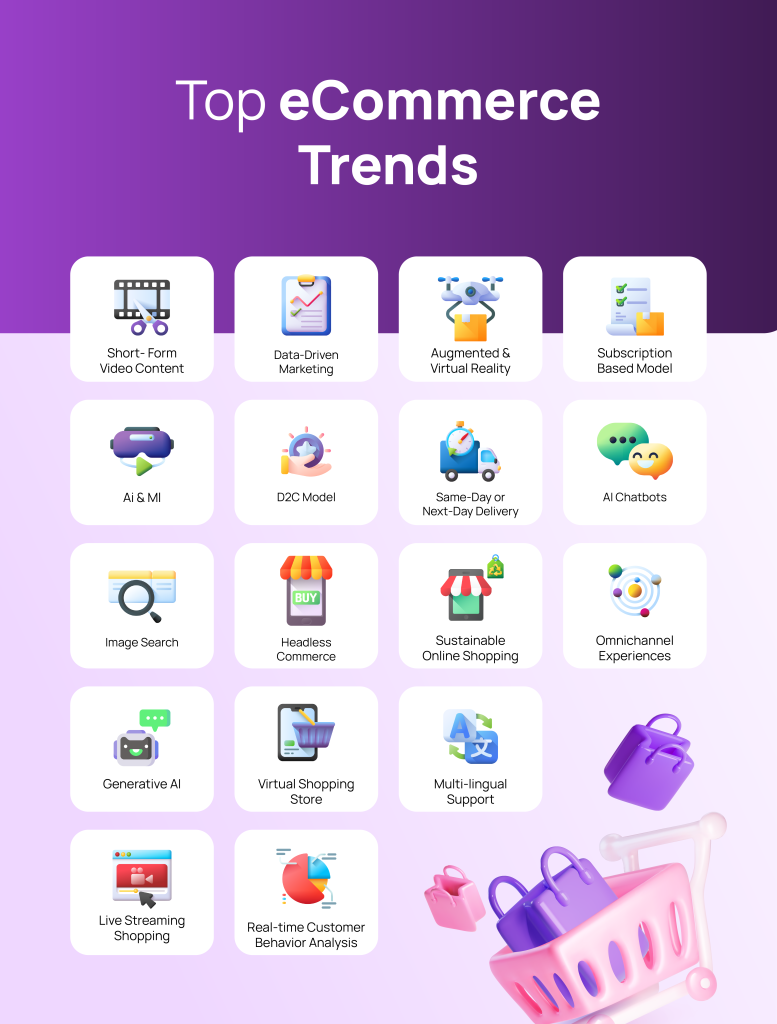Table of Contents
Want to experience a new wave of eCommerce that will disrupt the online shopping market?
As we enter 2025, the eCommerce industry is observing new advancements and trends. From virtual shopping stores to AI-powered assistants, the latest eCommerce trends are setting new benchmarks for how people shop online.
India’s eCommerce market is set for significant growth, projected to hit $325 billion by 2030 at a CAGR of 21%. So, if you plan to start your brand, then you must be aware of these eCommerce trends 2025 that are set to bring dramatic change.

Real-Time Customer Behaviour Analysis
One of the most impactful eCommerce trends in 2025 is real-time behavioural analysis. By analysing a customer’s actions, preferences, and interactions with an online store in real-time, brands can offer personalised recommendations, optimise user experiences, and even predict future behaviour. This insight allows businesses to tailor their marketing efforts, product offerings, and customer service strategies more effectively, fostering deeper connections and driving sales.
Multi-lingual Support
As eCommerce continues to grow globally, multilingual support will become a critical trend. Offering website content, customer service, and support in multiple languages helps eCommerce businesses cater to international customers and break down barriers to sales. In 2025, one of the latest eCommerce trends is providing seamless multi-lingual shopping experiences, which is crucial for brands aiming to expand their reach and appeal to diverse markets worldwide.
Virtual Shopping Store
In 2025, virtual shopping stores will be one of the most innovative ways to engage with customers. With the help of virtual reality (VR) and augmented reality (AR), customers will be able to walk through virtual stores, browse products, try them on, and interact with sales associates in a fully immersive environment. Virtual shopping will blend the convenience of online shopping with the tactile experience of traditional retail, offering an unparalleled shopping experience from the comfort of home.
Generative AI in eCommerce
Generative AI will continue to transform the eCommerce landscape in 2025. From creating product descriptions to designing personalised marketing campaigns, generative AI can automate and enhance a wide range of eCommerce processes. Additionally, generative AI will be used for product recommendation engines, improving customer personalisation by analysing data to create more relevant shopping experiences.
Omnichannel Experiences
Consumers today expect a seamless shopping experience, regardless of the platform or device they use. Omnichannel retailing, which integrates online and offline channels, will be a key trend in 2025. Whether it’s shopping in-store, on a website, or through a mobile app, customers should be able to access their shopping history, receive personalised recommendations, and complete purchases without friction. By offering a unified omnichannel experience, eCommerce businesses can build stronger relationships with customers and increase loyalty.
Sustainable Online Shopping
Sustainability is becoming a major concern for consumers, and eCommerce businesses will need to adapt. By 2025, sustainability will be a key driver in the buying decisions of many consumers. Whether it’s through eco-friendly packaging, carbon-neutral shipping, or ethically sourced products, businesses will need to integrate sustainable practices into their eCommerce strategies. Offering sustainable options will not only appeal to eco-conscious consumers but also align with growing environmental concerns.
Headless Commerce
Headless commerce is gaining traction as eCommerce businesses look for more flexibility and agility in delivering seamless shopping experiences. By decoupling the front-end and back-end of an eCommerce platform, businesses can offer personalised, responsive, and innovative user interfaces across different touchpoints. In 2025, headless commerce will allow brands to rapidly adapt to changing customer demands and technologies without the constraints of traditional platforms.
Image Search
In 2025, image search will become a mainstream feature of eCommerce platforms. With the power of AI and machine learning, customers will be able to search for products simply by uploading a photo or taking a picture of an item they like. This will enable consumers to discover similar products without needing to know the exact name or description, improving the shopping experience and reducing friction in the buying process.
Use of AI Chatbots in Online Shopping
AI-powered chatbots will continue to play a major role in eCommerce in 2025. These intelligent assistants can engage with customers in real-time, answer questions, provide product recommendations, and even help with order tracking. By leveraging AI, businesses can provide instant support, improve customer satisfaction, and streamline the shopping process. Chatbots will become more conversational, offering personalized experiences tailored to individual preferences.
Livestreaming Shopping
Livestream shopping is one of the most exciting eCommerce trends to watch in 2025. With platforms like TikTok, Instagram, and YouTube already integrating live shopping features, this trend is expected to grow rapidly. By combining live video with interactive shopping experiences, brands can engage customers in real-time, showcase products, and offer exclusive deals. Livestream shopping brings an exciting level of interactivity and entertainment to online shopping.
Same-Day or Next-Day Delivery
Consumers are increasingly demanding faster shipping options, and in 2025, eCommerce trends include same-day or next-day delivery, which will become the standard for many eCommerce brands. Companies that can offer fast, reliable delivery will have a significant competitive advantage. Advances in logistics, fulfilment centres, and last-mile delivery will make it possible for businesses to meet these expectations, providing customers with a better shopping experience.
Expansion of Direct-to-Consumer Model
The Direct-to-Consumer (DTC) model has been gaining popularity in recent years, and by 2025, it will be more widespread. This model allows brands to cut out intermediaries, build direct relationships with customers, and have greater control over their branding, pricing, and customer experience. More brands will embrace D2C, especially as they look for ways to improve margins and better understand their customers’ needs.
Use of AI and ML in eCommerce App Development
Artificial Intelligence (AI) and Machine Learning (ML) are set to play an even larger role in eCommerce app development in 2025. From predictive analytics to personalizing user interfaces, AI and ML will enable brands to offer more intuitive and efficient shopping apps. Machine learning algorithms will analyse user behaviour to improve product recommendations, while AI-driven customer service features will streamline support and enhance the overall user experience.
Growth in Subscription-Based Models
Subscription-based eCommerce models will continue to rise in popularity in 2025. Whether it’s monthly product boxes, content subscriptions, or services, the subscription model offers convenience and exclusivity. Customers appreciate the convenience of having products delivered regularly, and businesses benefit from predictable, recurring revenue. In 2025, expect to see even more industries adopting subscription models, from beauty to food to entertainment.
Augmented and Virtual Reality
Augmented Reality (AR) and Virtual Reality (VR) technologies will revolutionise the way consumers shop online in 2025. AR and VR will allow customers to virtually try on clothes, test products, and see how items fit into their homes before making a purchase. This immersive experience will reduce uncertainty, build trust, and increase the likelihood of purchases. In industries like furniture, fashion, and beauty, AR and VR will be particularly impactful.
Predictive Intelligence for Data-Driven Marketing
Predictive intelligence will become a critical tool for data-driven marketing in 2025. By analysing past consumer behaviour, brands can predict future actions and tailor marketing efforts accordingly. This will enable businesses to deliver highly personalised ads, recommendations, and promotions to individual consumers, improving conversion rates and customer satisfaction. Predictive intelligence will also help brands forecast inventory needs and optimise supply chains.
Short-Form Video Content
Short-form video content will continue to dominate eCommerce marketing strategies in 2025. With the success of platforms like TikTok and Instagram Reels, short-form videos have proven to be an effective way to capture consumer attention and drive engagement. Whether it’s showcasing a product in action, telling a brand story, or providing behind-the-scenes content, short-form videos will be essential for businesses looking to stay relevant in a fast-paced digital world.
The Bottom Line
The eCommerce industry is set to undergo exciting transformations in 2025, driven by technological advancements, evolving consumer preferences, and the ongoing demand for more personalised and seamless shopping experiences. Whether it’s harnessing the power of AI, offering real-time insights, or embracing sustainability, the future of eCommerce is dynamic and full of potential.
As businesses navigate these changes, platforms like Dispatch, an eCommerce shipping company, will play an integral role in ensuring fast and reliable delivery, helping companies meet rising consumer expectations in 2025.
Staying on top of these trends will allow eCommerce businesses to stand out, drive customer loyalty, and ultimately thrive in an increasingly competitive market.
Calculate Your Shipping Rates

| Courier Partner | Mode | Chargeable Weight (KG) | Shipping Rates |
|---|



